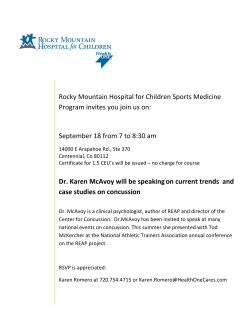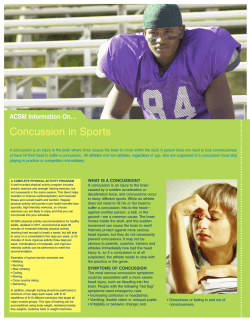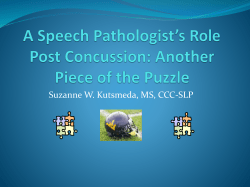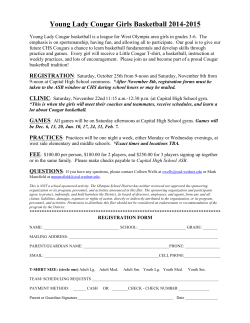
Vestibular rehabilitation of the post-concussive athlete Chuck DiSanto PT, COMT, CHT, OCS
Vestibular rehabilitation of the post-concussive athlete Chuck DiSanto PT, COMT, CHT, OCS Physical Therapist Certified Orthopedic Manual Therapist Certified Hand Therapist Orthopaedic Certified Specialist Certified in Vestibular Rehabilitation Course Description Description: This work shop will introduce the anatomy and physiology of associated structures involved in concussion. The participant will become familiar with common presenting dysfunctions of this injury. Objective assessments of these impairments will also be discussed and reviewed. Individuals will have an opportunity to learn and practice specific evidence based rehabilitative interventions. When completed, the participant should have a working ability to identify and treat impairments associated with the concussive athlete. Objectives 1. Discuss the basic anatomy and physiology of vestibular structures and the relationship of the neck. 2. Demonstrate basic clinical assessments of self reported questionnaires and objective balance tests. 3. Demonstrate specific vestibular, strengthening, and balance exercises to aid with the rehabilitation of the concussed athlete. Course rationale Rationale: Concussion is a common and serious problem within the athletic population. Some athletes may have lingering complaints of dizziness, headache and balance deficits. Recent research demonstrates that vestibular rehabilitation may be an important tool in the recovery of these individuals, however, more needs to be done with the development of evidence based exercise prescription for these athletes. Understanding the anatomy, physiology and treatment options for specific impairments may aid in a quicker and more complete recovery. What is vestibular rehabilitation? Specialized care ►A well established and accepted intervention for persons with balance and vestibular disorders. ►We work on restoring function with a multifaceted individualized approach for total well being What is vestibular rehabilitation? ► Cawthorne and Cooksey The 1950’s Exercises used for dizziness Incorporated eye, head, and trunk exercises in varying functional positions Progressive, dynamic, functional exercises Still found to be effective today - Corna, et al. 2003 Is vestibular rehabilitation an effective treatment for concussion ? ► “Vestibular rehabilitation for dizziness and balance disorders after concussion.” ► Conclusion: “ Vestibular rehabilitation should be considered in the m anagem ent of individuals post concussion w ho have dizziness and gait and balance dysfunctions that do not resolve w ith rest.” Alsalaheen BA, et al. J Neurol Phys Ther. 2010 ► Vestibular rehabilitation for mTBI and closed head injury in the non-athletic population ► Larger body of evidence ► Well established What is a Concussion ► “Concussion is a complex pathophysiologic process induced by traumatic forces secondary to direct or indirect forces to the head that disrupts the function of the brain. This disturbance of brain function is typically associated with normal structural neuroimaging findings (i.e., computed tomography scan, magnetic resonance imaging). It results in a constellation of physical, cognitive, emotional, and/or sleep-related symptoms and may or may not involve a loss of consciousness.” Centers for Disease Control and Prevention ► A stunning, damaging, or shattering effect from a hard blow; : a jarring injury of the brain resulting in disturbance of cerebral function. Merriam-Webster Dictionary ► To shake violently First Known Use: 14th century ► Concussion incidence Concussion is one of the most prevalently acquired neurologic conditions occurring in children and young adults. 3.8 million concussions occur in the USA per year As much as 50% can go unreported -football -hockey -rugby ► -soccer -basketball Concussion is described as a “mild traumatic brain injury.” Concussion Physiology Neurometabolic Cascade 1. Release of neurotransmittersGlutamate 2. Massive neuron firing. Creates large cellular demand. 3. Calcium influx blocking oxygen preventing cellular respiration 4. K+ efflux cause vasoconstriction 5. This prevents fuel, glucose, from getting to the cells. 6. This leads to cellular death and dysfunction Giza CC, Hovda DA. 2001 . Concussion signs and symptoms ► ► ► ► ► ► ► ► ► ► ► Signs Observed by Coaching Staff Appears dazed or stunned Is confused about assignment or position Forgets an instruction Is unsure of game, score, or opponent Moves clumsily Answers questions slowly Loses consciousness (even briefly) Shows mood, behavior, or personality changes Can’t recall events prior to hit or fall Can’t recall events after hit or fall Symptoms Reported by Athlete Headache or “pressure” in head Nausea or vomiting Balance problems or dizziness Double or blurry vision Sensitivity to light Sensitivity to noise Feeling sluggish, hazy, foggy, or groggy Concentration or memory problems Confusion Does not “feel right” or is “feeling down” Use of a graded symptom check list Post concussion syndrome ► “Ongoing symptoms are either a prolonged version of the concussion pathophysiology or a manifestation of other processes, such as cervical injury, migraine headaches, depression, chronic pain, vestibular dysfunction, visual dysfunction, or some combination of conditions. The pathophysiology of ongoing symptoms from the original concussion injury may reflect multiple causes: anatomic, neurometabolic, and physiologic.” Leddy JJ, et al. 2012 CONCLUSIONS: “Treatment approaches depend on the clinician's ability to differentiate among the various conditions associated with PCS. Early education, cognitive behavioral therapy, and aerobic exercise therapy have shown efficacy in certain patients but have limitations of study design.”Leddy JJ, et al. 2012 A thorough assessment is required DOI and mechanism ►Age/gender ►Details of injury ►Premorbid functioning Learning disability Concussion history Substance abuse Migraines Depression and or anxiety Coping and academics Social support ►Other compounding injuries Medical History ► ► ► ► ► ► ► ► ► ► ► ► ► ► Complicating factors Previous TBI Headaches A serious associated injury Psychiatric illness- clinical depression or anxiety before the injury Female gender- Women are more likely to suffer and with greater severity than men Being older than 40 and female Alcohol abuse Low cognitive abilities prior to the injury Factors that increase the risk for persisting post-concussion symptoms An injury associated with acute headache, dizziness, or nausea Low socioeconomic status Glasgow Coma score of 13 or 14 Post-traumatic amnesia People who experience stress, have traumatic memories of the event, or expect to be disabled by the injury. Prognostic factors Risk Factors for concussive symptoms 1 week or longer in high school athletes RESULTS: “Presenting with four or more symptoms was associated with double the risk for concussive symptoms ≥1 week for both football (95% CI = 1.3-3.5) and non-football players (95% CI = 1.4-4.6). History of prior concussion was associated with double the risk for concussive symptoms ≥1 week in football players only (95% CI = 1.3-3.5). Several symptoms were associated with concussive symptoms ≥1 week in all athletes: drowsiness, nausea and concentration difficulties. Sensitivity to light and noise was associated with concussive symptoms ≥1 week in non-football players only. Amnesia was associated with concussive symptoms ≥1 week in males, but not females. Loss of consciousness was not significant.” Chrisman SP, et al. Brain Inj. 2013 Dizziness ► About 23% of the patients with concussion present with dizziness Causes ► Inner ear disorders BPPV Labyrinthe concussion Perilymphatic fistula ► CNS Disorders Post-traumatic migraine Brainstem concussion Autonomic dysregulation (Orthostatic Hypotension) Occulomotor abnormalities Seizures Psychological disorders Musculoskeletal disorders Outcome measures ► Dizziness Handicap Index (DHI) Reliable outcome measure in evaluating the progress of patients with balance disorders associated with TBI. Gotshall, et al. 2003 ► (VAS) - Visual Analog Scale Postural stability ► Impaired postural control is a common problem after concussion. Guskiewicz, 2003. Sosnoff, et al. 2011 ► May have lasting effects “Persistent motor system abnormalities in formerly concussed athletes.” DeBeaumont, et al. 2011 Postural stability ►How we keep our balance Vestibular system Proprioceptive system Joint mobility Muscle power Muscle tone Gait pattern COMBINED SYSTEMS Model How we keep our balance vision Vestibular system Central Nervous system Somatosensory Postural Stability ► How we keep our balance Balance strategies ►Ankle ►Hip ►Stepping ►Falling Postural stability Reliable objective testing Balance Error Scoring System (BESS) “The value of balance assessment measurements in identifying and monitoring acute postural instability among concussed athletes.” Cripps, et al. 2012 Sensory Organization Test (SOT) Clinical Test for Sensory Interaction in Balance (CTSIB) ►Modified CTSIB Dynamic Gait Index (DGI) Five Times Sit to Stand Balance/Dizzy Lab Bess test DHI Balance strategies Postural stability ► Treatment of postural control Effectiveness of physical therapy for improving gait and balance in individuals with traumatic brain injury. Conclusion: “The state of evidence for gait and balance interventions in patients with mild-to-moderate TBI is surprisingly poor.” Bland, et al. Brain Inj. 2011 Postural stability What might work: ►Sensory integration exercises ►Oculomotor training ►Eye-Head coordination ►Balance training ►Visual motion sensitivity training ►Neuromuscular control ►Body mechanics and posture Sensory integration exercises ► Spatial orientation 5 sensory modalities working together ►Vision ►Vestibular ►Proprioception ►Touch and pressure ►Hearing ► CTSIB Visual overreliance Oculomotor training Anatomy and physiology Oculomotor problems Ocular alignment Smooth pursuit Gaze-evoked nystagmus Saccades Gaze fixation Optokinetic reflex Visual acuity ► Visual acuity (VA) is acuteness or clearness of vision, which is dependent on the sharpness of the retinal focus within the eye and the sensitivity of the interpretative faculty of the brain. Static Dynamic Oculomotor Lab ► Observation Spontaneous nystagmus Ocular alignment ► Skew deviation ► Smooth pursuit ► Saccades ► Gaze fixation ► Vergence ► Eye strain End range pain Visual Acuity Lab Vestibular reflexes ► Reflexes Vestibulospinal Reflex (VSR) ► Provides postural stability ► Balance strategies Vestibulocollic Reflex (VCR) ► Activates muscles in the neck to stabilize the head during motion ► Aligns the head in relationship to gravitational vertical Vestibulo-ocular Reflex (VOR) ► Gaze stability on a target during rapid head movements Eye and Head movements The vestibulo-ocular reflex (VOR) or oculovestibular reflex is a reflex eye movement that stabilizes images on the retina during head movement by producing an eye movement in the direction opposite to head movement, thus preserving the image on the center of the visual field. Stabilizes vision Eyes and head move in opposite directions Gain Assessment Treatment ► Adaptation progression VOR Lab Assessment ►Head impulse test 30 degrees flexion ►Dynamic ► visual acuity Head shake test 30 degrees flexion Treatment progression X The Neck Upper cervical spine-O-A, A-A ► Associated neural relationships ► Associated anatomical relationships ► Associated dysfunctions elsewhere -Jaw and Thoracic spine Cervical reflexes ► Reflexes The Cervicoocular Reflex (COR) Weak reflex ► Does not play direct role in gaze stability ► May help VOR to compensate ► Prorioceptors and somatosensory receptors -C1-C2 dorsal nerve roots ► • Cervicospinal Reflex (CSR) -acts in conjuction with the VSR -provides postural stability through limb activation The Cervicocollic Reflex (CCR) Provides head stability ► Contraction of stretched muscles to align the head ► ► “The bad ground wire” Neck ► Differential Vibration diagnosis ► Nystagmus Decreased ROM ► Dizzy with ► Norms movements Palpation ► Painful ► Reproduction of symptoms Positive special tests ► Ligament ► VBI Head rotation/Trunk rotation Neck Treatment ►Manual therapy ►Stabilization/proprioception ►Strengthening Neck strengthening Lack of evidence in concussion prevention ► Hold test The Craniocervical Flexion Test The Deep Neck Flexor Endurance Test ► Exercises ► Core Scapular stabilization Neck Lab ► The Craniocervical Flexion Test ► The Deep Neck Flexor Endurance Test ► Head/trunk rotation test ► Upper cervical rotation test ► Ligament testing ► Vibration TMJ May be the result of the head blow or pre-existing ► Well known to cause vertigo and tinnitus ► Chole RA, Parker WS. 1992. TMJ ► Needs to be included in our evaluation Observation of the face and mouth Joint noise ►Clicks ►Crepitus Tenderness at the muscles of mastication Limited motion Malocclusions Deviations with mandibular depression Change in symptoms with jaw movement Neuromuscular control ► Neck Bobble head Neck strength Kinesthetic sense ► Proprioceptiton Postural sense Gait Tandem gait Finger to nose SLS Balance training Functional ►Sports specific ►Individualized SLS Quick turns Amb with head turns Cone pick up Dual tasking ► Ball throw with grape vine Standing on foam with head turns Putting it all together Neuromuscular Lab ► Proprioceptive ► SLS EO EC Cognitive task ► Romberg ► Tandem gait EO/EC ► Finger to nose ► EC walking exercise Peripheral Vestibular Issues Perilymphatic Fistula ►Tullio's Phenomenon -Consists of dizziness induced by sound -Valsalva -Hennebert sign BPPV ►BPPV Brief episode of spinning with positional changes ►Cupulolithiasis vs canalithiasis Nystagmus BPPV Assessment ► HALLPIKE-DIX Torsional nystagmus ► ROLL TEST ►Apogeotropic/Geotropic Horizontal nystagmus BPPV Treatment ► Canalith Repositioning Canal specific About 70-90% success with one treatment session Well tolerated and safe Complications ►conversion Brandt-Daroff •Central reprocessing versus particle repositioning BPPV testing and repositioning lab ► Hallpike-Dix ► Roll test ► Epley ► Brandt-Daroff Aerobic exercise ► Aerobic exercise Leddy et al. 2012 ► Graded exercises ►Baker, et al. 2012 – Limited study ► 72% who participated in exercise returned to full function ► 1 in 6 who did not exercise returned to full function ► Vidal, et al. 2012, Gagnon,et al. 2009 “active rehabilitation” better than strict rest - Exercises should be submaximal, progressive and should not induce symptom exacerbation Physical Activity Tolerance ► Rest ► is still the first stage of recovery Sub-symptom threshold exercise training “A preliminary study of sub-symptom threshold exercise training for refractory post-concussion syndrome.” CONCLUSIONS: “Treatment with controlled exercise is a safe program that appears to improve PCS symptoms when compared with a no-treatment baseline. A randomized controlled study is warranted.” Leddy, et al. 2010 Use of heart rate monitor and/or Borg/PRE can be incorporated How about headaches? ► Most common symptom associated with concussion ►Are headaches a good indicator of recovery? Headaches ► “Systematic review of interventions for posttraumatic headache.” ►No strong evidence from clinical trials is available to direct the treatment of PTHA. Watanbe, et al. 2012 ►What about cervicogenic headache ►Jaw ►Oculomotor If the headache a centralized problem are there identifiable peripheral amplifiers? Headache ► Factors that may trigger or exacerbate headaches Cervical spine injury Impaired sleep Higher level cognition Vision Hearing sensitivity Exercise Flexion-Rotation Test for Cervicogenic Headache ► “The cervical flexion-rotation test significantly assists in the differential diagnosis of cervicogenic headache and in the identification of movement impairment at the C1/2 segment in patients with cervicogenic headache.“The diagnostic validity of the cervical flexion-rotation test in C1/2-related cervicogenic headache Ogince M, et al, Man Ther. 2007. Conclusion ► Vestibular rehab can work ► Individualized multidisciplinary approach ► We need to be better able to detect signs and symptoms that may trigger early intervention and more comprehensive and specific care ► More work to be done in the future
© Copyright 2025





















